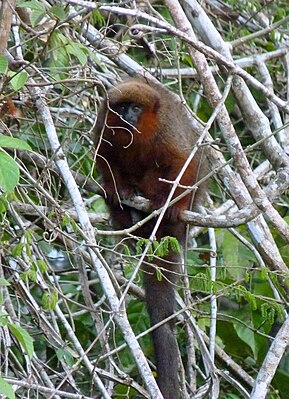Madidi spring monkey
| Madidi spring monkey | ||||||||||||
|---|---|---|---|---|---|---|---|---|---|---|---|---|

Madidi spring monkey ( Plecturocebus aureipalatii ) |
||||||||||||
| Systematics | ||||||||||||
|
||||||||||||
| Scientific name | ||||||||||||
| Plecturocebus aureipalatii | ||||||||||||
| ( Wallace , 2005) |
The Madidi Spring monkey ( Plecturocebus aureipalatii , Syn .: Callicebus aureipalatii ) is a primate species from the subfamily of the Spring monkeys within the family of the Sakia monkeys (Pitheciidae). It got its scientific name from an online casino after an auction.
features
Madidi jumper monkeys, like all jumper monkeys, are relatively small primates with thick fur . This is gray-brown on the back, the stomach as well as the forearms and legs and the paws are colored orange-red. The tail is long and bushy and, like all jumper monkeys, cannot be used as a prehensile tail. It is mostly dark in color, but has a white tip. The head is small, rounded, its golden yellow top is characteristic. The hair on the cheeks and throat are colored orange-red.
distribution and habitat
Madidi jumping monkeys live at the foot of the Andes in the north of the Bolivian department of La Paz . Possibly their distribution area extends into eastern Peru . Their habitat are forests, especially those with dense vegetation, where they can be found at a height of up to 500 meters.
Way of life
Like all jumping monkeys, these primates are diurnal tree dwellers. They move in the branches either four-legged or by jumping, for which they are adapted with their relatively long hind legs. Like all other jumping monkeys, they live in monogamous family groups that consist of their parents and their offspring and in which the partners often stay together for life. The groups live in fixed territories of around 17 to 25 hectares in size. With duet songs, they draw the attention of animals outside the group to their territory and, if necessary, defend it. Their diet consists mainly of fruits, to a lesser extent also of other parts of the plant. The fathers participate intensively in raising the young, they carry the young around and only give it to the mother to suckle.
Madidi monkeys and humans
The new primate species was discovered by Robert Wallace in the Madidi National Park in northwestern Bolivia. Instead of naming the species after an important biologist or taxonomic characteristics as usual, it was decided to auction the naming rights in order to raise money for the organization FUNDESNAP , which is committed to the preservation of the Bolivian national parks. The online casino GoldenPalace.com won the auction for $ 650,000.
The threats for this species include hunting and the destruction of their habitat, but overall it is listed by the IUCN as "not endangered" ( least concern ).
literature
- Thomas Geissmann : Comparative Primatology. Springer-Verlag, Berlin et al. 2003, ISBN 3-540-43645-6 .
Web links
- Plecturocebus aureipalatii in the endangered Red List species the IUCN 2009. Posted by: R. B. Wallace, S. de La Torre, L. M. Veiga, 2008. Accessed on 5 November of 2009.
- Madidi Titi (Callicebus aureipalatii) at theprimata.org (English)
- Official website GoldenPalace.com Monkey (English)